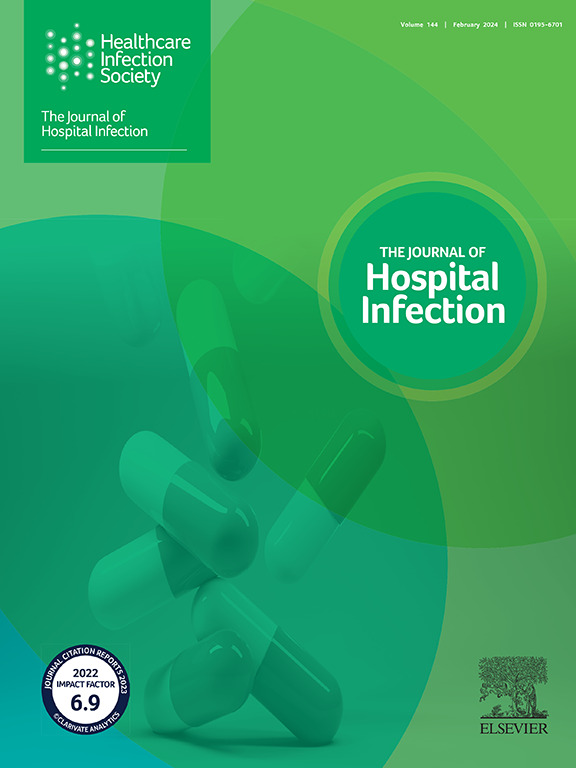Assessing the role of environment in Pseudomonas aeruginosa healthcare-associated bloodstream infections: a one-year prospective survey
IF 3.1
3区 医学
Q1 INFECTIOUS DISEASES
引用次数: 0
Abstract
Background
Deciphering precise sources and patterns of healthcare-associated Pseudomonas aeruginosa colonization/infection is crucial in defining strategies of prevention and control.
Aim
To prospectively investigate the role of hospital environment in P. aeruginosa nosocomial bloodstream infections (Pa-BSIs) during one year in a tertiary-care hospital.
Methods
Clinical records of patients presenting Pa-BSIs after >48 h of hospitalization were investigated to confirm the nosocomial character of BSIs and identify the routes of entry and risk factors. Environmental investigations were performed to track P. aeruginosa source/reservoir along the care pathway. Clinical and environmental strains were compared by whole-genome sequencing to identify the route of contamination from hospital environment to patients.
Findings
Fifty-three BSIs episodes in 49 patients were considered as nosocomial, mostly involving men (73%), with an average age of 62.4 years, immunosuppressed in >40% of cases, and after previous antibiotic therapy in almost 92% of cases. BSIs occurred after 27 days of hospitalization on average. The main routes of entry were urinary (30%, on indwelling catheters for two-thirds of cases) and cutaneous (17%, catheter-related in almost 80% of cases). P. aeruginosa was found in 16 out of 49 investigations, representing 34 positive samples, including 54% of sink traps, 23% of water, and 20% of tap aerators. An epidemiological link was established between environmental and clinical strains only for eight patients, representing 15% of nosocomial BSIs.
Conclusion
The hospital environment usually considered as the main source of P. aeruginosa healthcare-associated infections was identified as responsible for nosocomial BSIs in only 15% of patients. Since the implementation of water and hospital environment management, one may hypothesize that P. aeruginosa has become a community-acquired pathogen with a nosocomial expression in infection.
评估环境在铜绿假单胞菌医源性血流感染中的作用:为期一年的前瞻性调查。
目的前瞻性研究一家三甲医院一年内医院环境在铜绿假单胞菌(Pa)院内血流感染(BSI)中的作用:方法: 对住院超过 48 小时后出现 Pa-BSIs 的患者的临床记录进行调查,以确认 BSIs 的院内性质,并确定进入途径和风险因素。对环境进行调查,以沿着护理路径追踪Pa来源/贮藏室。通过全基因组测序对临床菌株和环境菌株进行比较,以确定从医院环境到患者的污染途径:49名患者中的53例BSI被认为是院内感染,大部分患者为男性(73%),平均年龄为62.4岁,超过40%的病例存在免疫抑制,近92%的病例曾接受过抗生素治疗。BSI 病例平均在住院 27 天后发生。主要感染途径是泌尿系统(30%,2/3 的病例通过留置导尿管感染)和皮肤(17%,近 80% 的病例与导尿管有关)。在 16/49 次调查中发现了 Pa,阳性样本为 34 个,其中 54% 的水槽疏水阀、23% 的水和 20% 的水龙头充气机中都发现了 Pa。只有 8 名患者的环境菌株与临床菌株之间建立了流行病学联系,占医院内 BSI 的 15%:结论:医院环境通常被认为是帕氏医疗相关感染的主要来源,但只有 15%的患者被确定为引起院内 BSI 的罪魁祸首。自实施水和医院环境管理以来,可以推测Pa已成为一种社区获得性病原体,并在感染中表现为医院内感染。
本文章由计算机程序翻译,如有差异,请以英文原文为准。
求助全文
约1分钟内获得全文
求助全文
来源期刊

Journal of Hospital Infection
医学-传染病学
CiteScore
12.70
自引率
5.80%
发文量
271
审稿时长
19 days
期刊介绍:
The Journal of Hospital Infection is the editorially independent scientific publication of the Healthcare Infection Society. The aim of the Journal is to publish high quality research and information relating to infection prevention and control that is relevant to an international audience.
The Journal welcomes submissions that relate to all aspects of infection prevention and control in healthcare settings. This includes submissions that:
provide new insight into the epidemiology, surveillance, or prevention and control of healthcare-associated infections and antimicrobial resistance in healthcare settings;
provide new insight into cleaning, disinfection and decontamination;
provide new insight into the design of healthcare premises;
describe novel aspects of outbreaks of infection;
throw light on techniques for effective antimicrobial stewardship;
describe novel techniques (laboratory-based or point of care) for the detection of infection or antimicrobial resistance in the healthcare setting, particularly if these can be used to facilitate infection prevention and control;
improve understanding of the motivations of safe healthcare behaviour, or describe techniques for achieving behavioural and cultural change;
improve understanding of the use of IT systems in infection surveillance and prevention and control.
 求助内容:
求助内容: 应助结果提醒方式:
应助结果提醒方式:


